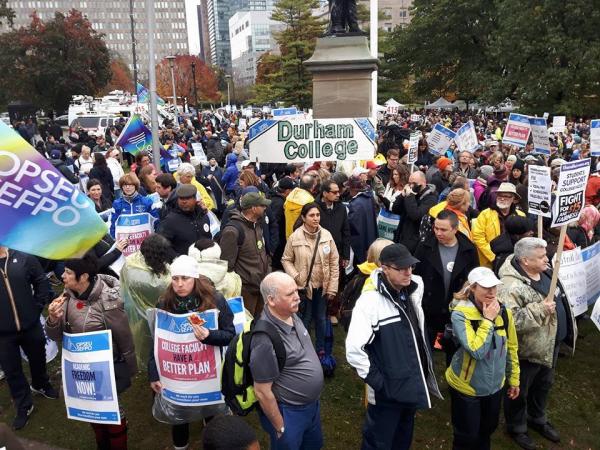13 Union Management Issues
Learning Objectives
By the end of the chapter, you should be able to:
- Explain why workers unionize and how unions are structured, and describe the collective-bargaining process.
- Discuss key terms associated with union/management issues, such as mediation and arbitration.
- Identify the tactics used by each side to support its negotiating position: strikes, picketing, boycotting, and lockouts.

Show What You Know
[h5p id=”30″]
Unions
As we saw in “Motivating employees”, Maslow believed that individuals are motivated to satisfy five levels of unmet needs (physiological, safety, social, esteem, and self-actualization). From this perspective, employees hope that full-time work will satisfy at least the two lowest-level needs: they want to be paid wages that are sufficient for them to feed, house, and clothe themselves and their families, and they expect safe working conditions and hope for some degree of job security.
Organizations also have needs: they need to earn profits that will satisfy their owners. They need to keep other stakeholders satisfied as well, which can cost money. Consider a metal-plating business that uses dangerous chemicals in its manufacturing processes; wastewater treatment is essential – and expensive. Sometimes, the needs of employees and employers are consistent: the organization can pay decent wages and provide workers with safe working conditions and job security while still making a satisfactory profit. At other times, there is a conflict—real, perceived, or a little bit of both—between the needs of employees and those of employers. In such cases, workers may be motivated to join a labour union—an organized group of workers that bargains with employers to improve its members’ pay, job security, and working conditions.
The following chart demonstrates that there has been an overall decrease in the percentage of workers in Canada who are union members from 1981 to 2012. It is interesting to note that this trend is not true for women in the workforce, where the participation rate has been fairly steady over that same 30 year period. The overall decrease is due to a number of factors. First, there has been a shift away from traditional manufacturing industries towards service industries, which are not as likely to be unionized. Some large multinational corporations have a strong anti-union stance, making it more difficult for employees to form unions in those companies.
Source: Statistics Canada https://www.statcan.gc.ca/pub/75-006-x/2013001/article/11878-eng.htm
Union Structure
Unions have a pyramidal structure much like that of large corporations. At the bottom are locals that serve workers in a particular geographical area. Certain members are designated as stewards to serve as go-betweens in disputes between workers and supervisors. Locals are usually organized into national unions that assist with local contract negotiations, organize new locals, negotiate contracts for entire industries, and lobby government bodies on issues of importance to organized labour. In turn, national unions may be linked by a labour federation, such as the Canadian Labour Congress (CLC), which provides assistance to member unions and serves as a principal political organ for organized labour.
Collective Bargaining
In a non-union environment, the employer makes largely unilateral, i.e., one-sided decisions on issues affecting its labour force, such as salary and benefits. Typically, employees are in no position to bargain for better deals. At the same time, however, employers have a vested interest in treating workers fairly. As we saw in Chapter 11, a reputation for treating employees well, for example, is a key factor in attracting talented people. Most employers want to avoid the costs involved in managing a unionized workforce; as a result, many offer generous pay and benefit packages in the hopes of keeping their workers happy – and un-unionized.
The process of setting pay and benefit levels is a lot different in a unionized environment. Union workers operate on a contract which usually covers some agreed-upon, multi-year period. When a given contract period begins to approach expiration, union representatives determine with members what they want in terms of salary increases, benefits, working conditions, and job security in their next contract. Union officials then tell the employer what its workers want and ask what they’re willing to offer. When there’s a discrepancy between what workers want and what management is willing to give—as there usually is—union officials serve as negotiators on behalf of their workforce, with the objective of extracting the best package of salary, benefits, and other conditions possible. The process of settling differences and establishing mutually agreeable conditions under which employees will work is called collective bargaining.
The Negotiation Process
Negotiations start when each side states its position and presents its demands. As in most negotiations, these opening demands simply stake out starting positions. Both parties usually expect some give-and-take and realize that the final agreement will fall somewhere between the two positions. If everything goes smoothly, a tentative agreement can be reached and then voted on by union members. If they accept the agreement, the process is complete and a contract is put into place to govern labour-management relations for a stated period. If workers reject the agreement, negotiators from both sides must go back to the bargaining table.
Mediation and Arbitration
If negotiations stall, the sides may call in outsiders. One option for engaging outside parties is called mediation, under which an impartial third party assesses the situation and makes recommendations for reaching an agreement. A mediator’s advice can be accepted or rejected by either side. If mediation does not result in an agreement, because one or both sides are unwilling to accept the decision of the third party, they may opt instead for arbitration, under which the third party studies the situation and arrives at a binding agreement. The key difference between mediation and arbitration is the word “binding” – whatever the third party says goes, because both the union and management have agreed to accept the decision of the third party as a condition of entering into the arbitration process.
Grievance Procedures
Another difference between union and non-union environments is the handling of grievances—worker complaints on contract-related matters. When non-union workers feel that they’ve been treated unfairly, they can take up the matter with supervisors, who may or may not satisfy their complaints. When unionized workers have complaints (such as being asked to work more hours than stipulated under their contract), they can call on union representatives to resolve the problem, in conjunction with supervisory personnel, who are part of company management. If the outcome isn’t satisfactory to the worker, the union can choose to take the problem to higher-level management on his or her behalf. If there is still no resolution, the union may submit the grievance to an arbitrator.
At times, labour and management can’t resolve their differences through collective bargaining or formal grievance procedures. When this happens, each side may resort to a variety of tactics to win support for its positions and force the opposition to agree to its demands.
Union Tactics
Unions have several options at their disposal to pressure company management into accepting the terms and conditions union members are demanding. The tactics available to the union include striking, picketing, and boycotting. When they go on strike, workers walk away from their jobs and refuse to return until the issue at hand has been resolved. As undergraduates at York University discovered when they arrived on campus in 2007, the effects of a strike can engulf parties other than employers and strikers: with two-hundred food services workers on strike, students had to scramble to find food at local mini-markets. The strike lasted from February 2nd to March 7th, and in the end, the workers got what they wanted: fairer wages, work protection and improvements to their health and dental plans.[1]

Though a strike sends a strong message to management, it also has consequences for workers, who don’t get paid when they’re on strike. Unions often ease the financial pressure on strikers by providing cash payments, which are funded from the dues members pay to the unions. It is important to note that some unionized workers may not have the right to strike. For example, strikes by federal employees, such as air-traffic controllers, can be declared illegal if they jeopardize the public interest.
When you see workers parading with signs outside a factory or an office building (or even a school), they’re probably using the tactic known as picketing (see Figure). The purpose of picketing is informative—to tell people that a workforce is on strike or to publicize some management practice that is unacceptable to the union. In addition, because other union workers typically won’t cross picket lines, marchers can sometimes interrupt the daily activities of the targeted organization. In 2009, approximately 24,000 City of Toronto Municipal Workers, unhappy about wages and loss of the right to bank and cash out unused sick leave, went on a five-week strike. At first, many citizen supported this right, but some of the most noticeable effects of the strike, including the halting of waste collection and the cancellation of summer recreation programming, created widespread concern and negative reactions from the Toronto population.[2]
The final tactic available to unions is boycotting, in which union workers refuse to buy a company’s products and try to get other people to follow suit. The tactic is often used by the Canadian Labour Congress, who often endorse national boycotts. In 2009, for example, they called for a boycott of Old Dutch snack products in support of 170 locked out union workers at their Calgary plant.
Management Tactics
Management doesn’t typically sit by passively, especially if the company has a position to defend or a message to get out. One available tactic is the lockout—closing the workplace to workers—though it’s rarely used because it’s legal only when unionized workers pose a credible threat to the employer’s financial viability. If you are a fan of professional basketball, you may remember the NBA lockout in 2011 (older fans may remember a similar scenario that took place in 1999) which took place because of a dispute regarding the division of revenues and the structure of the salary cap.
Lockout tactics were also used in the 2011 labour dispute between the National Football League (NFL) and the National Football League Players Association when club owners and players failed to reach an agreement on a new contract. Prior to the 2011 season, the owners imposed a lockout, which prevented the players from practising in team training facilities. Both sides had their demands: the players wanted a greater percentage of the revenues, which the owners were against. The owners wanted the players to play two additional regular season games, which the players were against. With the season drawing closer, an agreement was finally reached in July 2011 bringing the 130-day lockout to an end and ensuring that the 2011 football season would begin on time.[3]

Another management tactic is replacing striking workers with strikebreakers—non-union workers who are willing to cross picket lines to replace strikers. Though the law prohibits companies from permanently replacing striking workers, it’s often possible for a company to get a court injunction that allows it to bring in replacement workers. For example, the NFL employed replacement referees in 2012, a move which led to a number of very questionable calls on the field.[4]
Why Managers Often Resist Unionization Efforts
No union organizing campaign ever started with the premise that by unionizing, employees would receive lower wages or weaker benefit programs. To the contrary, unions approach prospective members with promises like higher pay, better health insurance, and more vacation time. Not surprisingly, then, business managers resist unions because they generally add to the cost of doing business. Higher costs can be addressed in several ways. Managers could accept lower profits, though such an outcome is unlikely given that owners/shareholders benefit from higher profits. They could raise prices and pass the higher costs along to customers, but doing so could hurt their competitiveness in the marketplace. Alternatively. they could find other ways to offset the increase in costs, but since managers are already supposed to be paying attention to costs, finding offsets can be quite difficult.
Another reason managers sometimes resist unionization is that unions often attempt to negotiate work rules that are to the benefit of their members. Business people who have worked in union environments have often complained of the lack of flexibility and the difficulty unions sometimes create in dealing with poor performing union employees. The grievance process can sometimes be long, cumbersome, and costly to administer.
Some companies find working with unions to be so unpleasant that they decide to voluntarily increase pay and benefits to preempt unions in advertising these benefits.
The History of Unions
Excerpted from CBC’s Highlights in Canadian Labour History, P. Philips writes:
Celebrated across the country, the holiday is often thought of as the last hurrah before kids head back to school and the long, hot days of summer give way to the crisp, fading days of autumn.
But Labour Day is more than just the unofficial end to summer — a fact many Canadians tend to forget.
The Labour Day holiday, however, was established to recognize the contribution that ordinary working people have made to the Canadian way of life, said Ken Georgetti, president of the Canadian Labour Congress.
This includes the right to fair wages, safe working conditions and compensation for injury, and equitable labour relations.
“Lots of people lost their lives in order to establish the right to refuse unsafe work and the right to be treated fairly and without discrimination,” said Georgetti. “We’ve done a lot and we’re very proud of it.”
[h5p id=”31″]
The Future of Unions
Union membership in Canada and the United States have been declining for some time. In Canada, the unionization rate fell from 37.6% in 1981 to 28.8% in 2014. So will membership continue to decline causing unions to lose even more power? The American Federation of Labour and Congress of Industrial Organization (AFL-CIO) is optimistic about union membership, pointing out recent gains in membership among women and immigrants, as well as health care workers, graduate students, and professionals.[5]
Convincing workers to unionize is still more difficult than it used to be and could become even harder in the future. Given their resistance to being unionized, employers have developed strategies for dissuading workers from unionizing—in particular, tactics for withholding job security. If unionization threatens higher costs for wages and benefits, management can resort to part-time or contract workers. They can also outsource work, eliminating jobs entirely. Many employers are now investing in technology designed to reduce the amount of human labour needed to produce goods or offer services. While it is impossible to predict the future, it is likely that unions and managers will remain adversaries for the foreseeable future.
Key Takeaways
Important terms and concepts
- Labour unions are organized groups of workers that bargain with employers to improve members’ pay, job security, and working conditions.
- When there’s a discrepancy between what workers want in terms of salary increases, benefits, working conditions, and job security and what management is willing to give, the two sides engage in a process called collective bargaining.
- If negotiations break down, the sides may resort to mediation (in which an impartial third party makes recommendations for reaching an agreement) or arbitration (in which the third party imposes a binding agreement).
- When unionized workers feel that they’ve been treated unfairly, they can file grievances—complaints over contract-related matters that are resolved by union representatives and employee supervisors.
- If labour differences can’t be resolved through collective bargaining or formal grievance procedures, each side may resort to a variety of tactics. The union can do the following.
- Call a strike (in which workers leave their jobs until the issue is settled)
- Organize picketing (in which workers congregate outside the workplace to publicize their position)
- Arrange for boycotting (in which workers and other consumers are urged to refrain from buying an employer’s products).
- Management may resort to a lockout—closing the workplace to workers—or call in strikebreakers (non-union workers who are willing to cross picket lines to replace strikers).


